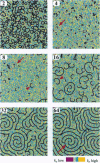Abstract
Randomly distributed Dictyostelium discoideum cells form cooperative territories by signaling to each other with cAMP. Cells initiate the process by sending out pulsatile signals, which propagate as waves. With time, circular and spiral patterns form. We show that by adding spatial and temporal noise to the levels of an important regulator of external cAMP levels, the cAMP phosphodiesterase inhibitor, we can explain the natural progression of the system from randomly firing cells to circular waves whose symmetries break to form double- and single- or multi-armed spirals. When phosphodiesterase inhibitor is increased with time, mimicking experimental data, the wavelength of the spirals shortens, and a proportion of them evolve into pairs of connected spirals. We compare these results to recent experiments, finding that the temporal and spatial correspondence between experiment and model is very close.
Full text
PDF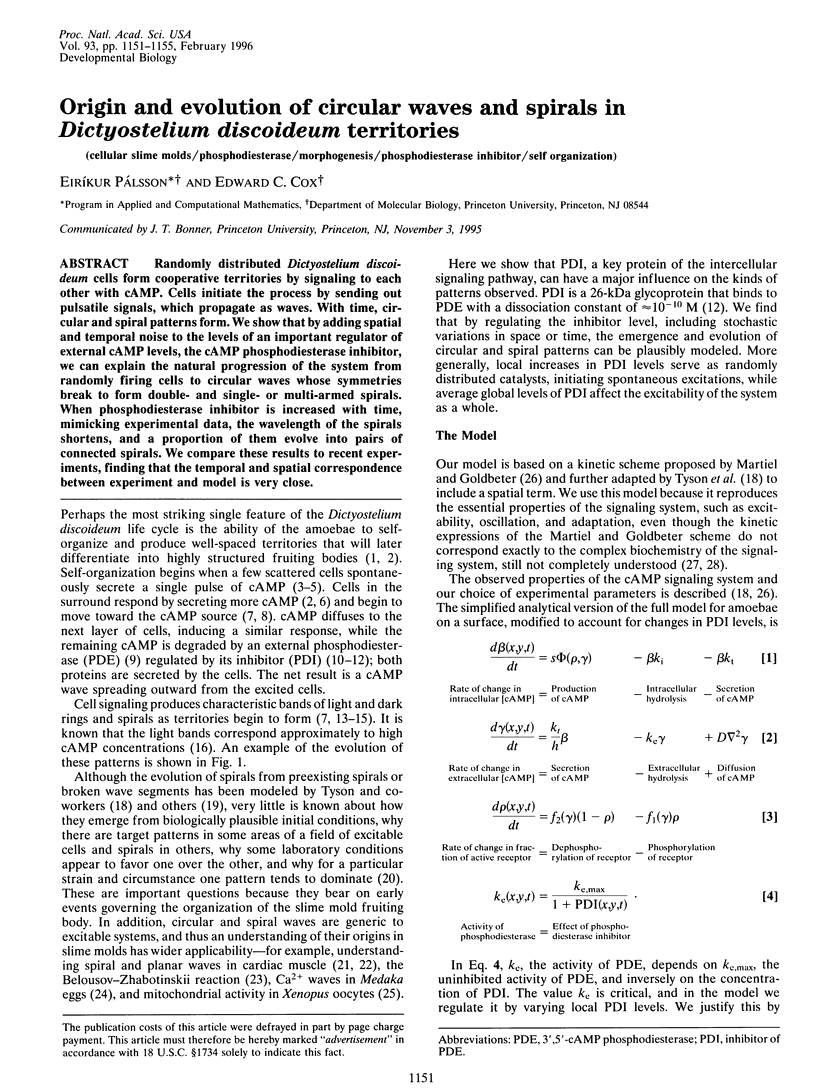
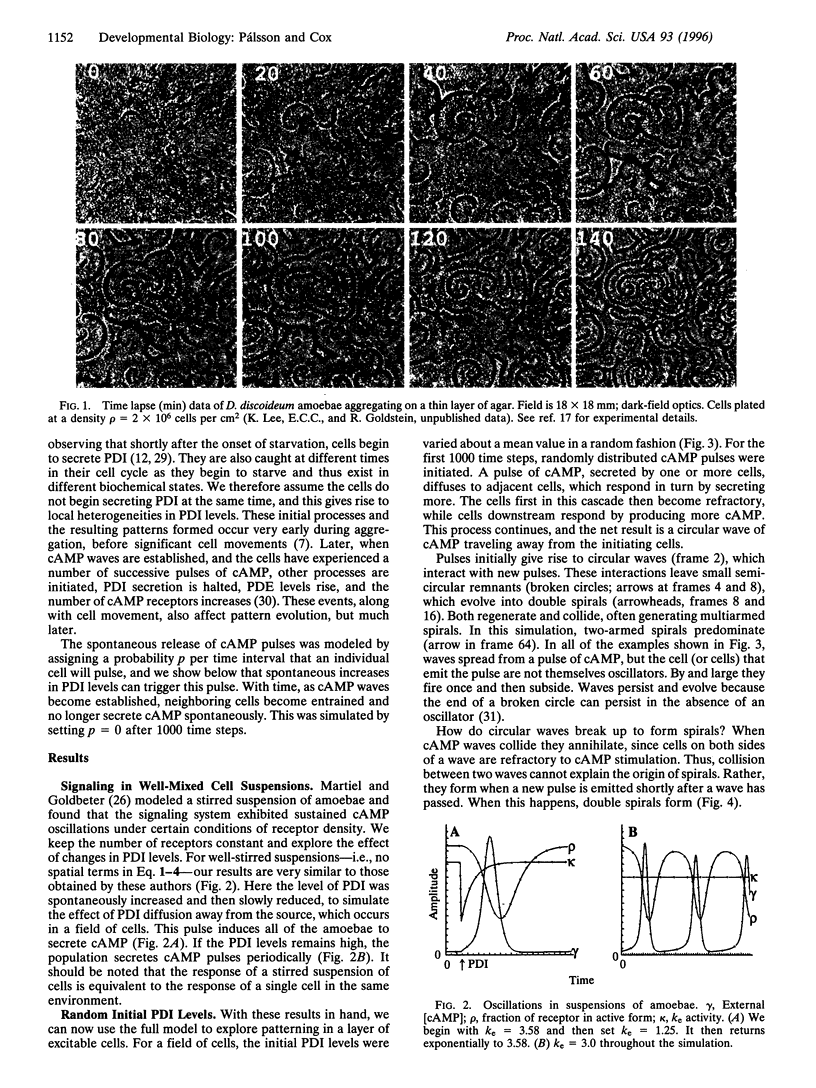

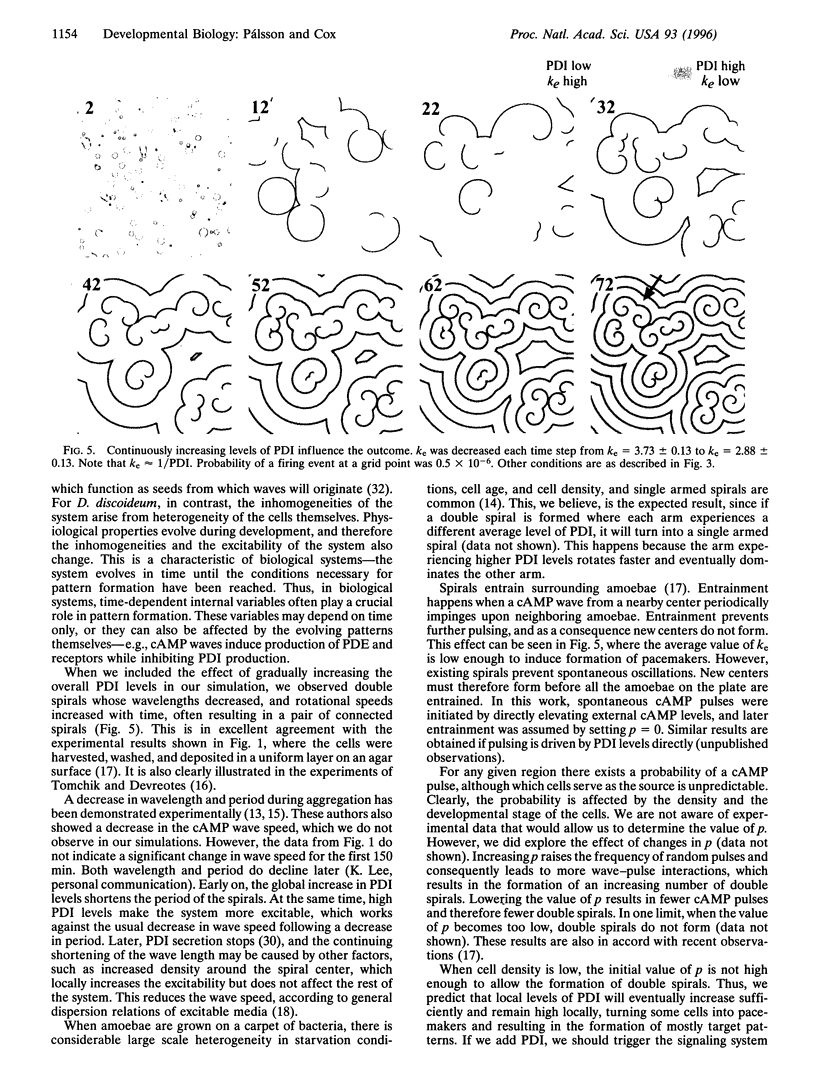
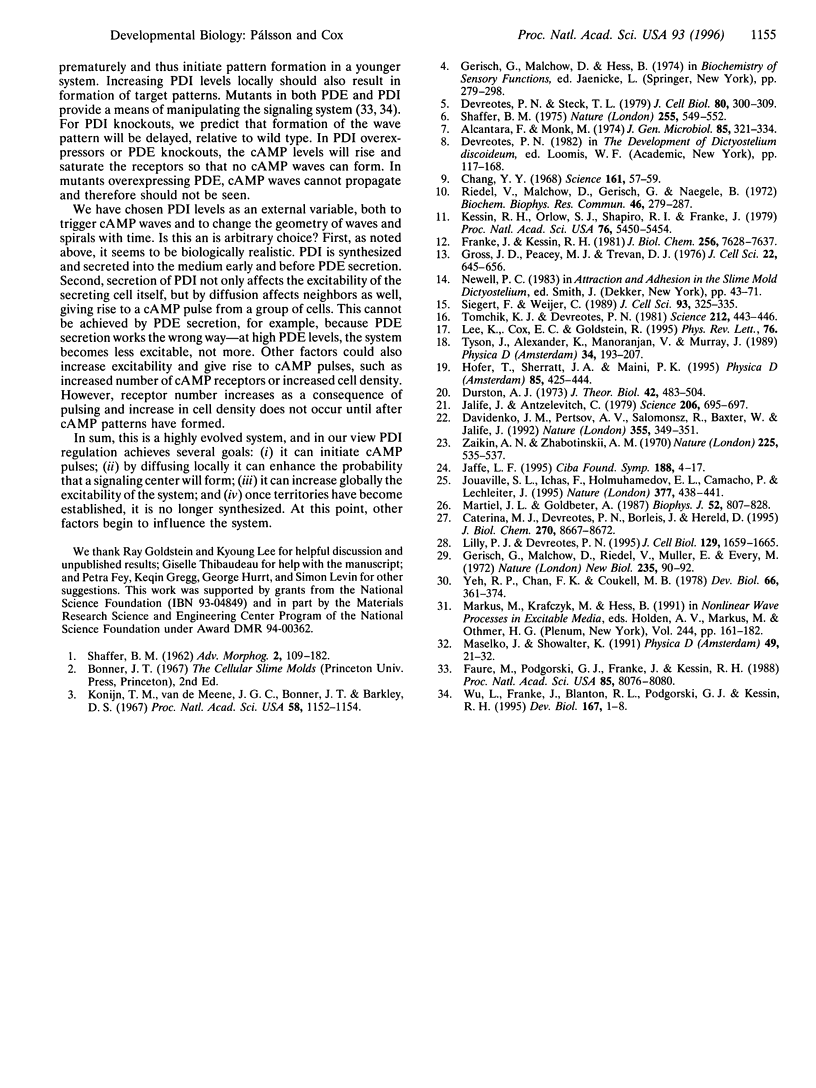
Images in this article
Selected References
These references are in PubMed. This may not be the complete list of references from this article.
- Alcantara F., Monk M. Signal propagation during aggregation in the slime mould Dictyostelium discoideum. J Gen Microbiol. 1974 Dec;85(2):321–334. doi: 10.1099/00221287-85-2-321. [DOI] [PubMed] [Google Scholar]
- Caterina M. J., Devreotes P. N., Borleis J., Hereld D. Agonist-induced loss of ligand binding is correlated with phosphorylation of cAR1, a G protein-coupled chemoattractant receptor from Dictyostelium. J Biol Chem. 1995 Apr 14;270(15):8667–8672. doi: 10.1074/jbc.270.15.8667. [DOI] [PubMed] [Google Scholar]
- Chang Y. Y. Cyclic 3',5'-adenosine monophosphate phosphodiesterase produced by the slime mold Dictyostelium discoideum. Science. 1968 Jul 5;161(3836):57–59. doi: 10.1126/science.161.3836.57. [DOI] [PubMed] [Google Scholar]
- Davidenko J. M., Pertsov A. V., Salomonsz R., Baxter W., Jalife J. Stationary and drifting spiral waves of excitation in isolated cardiac muscle. Nature. 1992 Jan 23;355(6358):349–351. doi: 10.1038/355349a0. [DOI] [PubMed] [Google Scholar]
- Devreotes P. N., Steck T. L. Cyclic 3',5' AMP relay in Dictyostelium discoideum. II. Requirements for the initiation and termination of the response. J Cell Biol. 1979 Feb;80(2):300–309. doi: 10.1083/jcb.80.2.300. [DOI] [PMC free article] [PubMed] [Google Scholar]
- Durston A. J. Dictyostelium discoideum aggregation fields as excitable media. J Theor Biol. 1973 Dec;42(3):483–504. doi: 10.1016/0022-5193(73)90242-7. [DOI] [PubMed] [Google Scholar]
- Faure M., Podgorski G. J., Franke J., Kessin R. H. Disruption of Dictyostelium discoideum morphogenesis by overproduction of cAMP phosphodiesterase. Proc Natl Acad Sci U S A. 1988 Nov;85(21):8076–8080. doi: 10.1073/pnas.85.21.8076. [DOI] [PMC free article] [PubMed] [Google Scholar]
- Franke J., Kessin R. H. The cyclic nucleotide phosphodiesterase inhibitory protein of Dictyostelium discoideum. Purification and characterization. J Biol Chem. 1981 Jul 25;256(14):7628–7637. [PubMed] [Google Scholar]
- Gerisch G., Malchow D., Riedel V., Müller E., Every M. Cyclic AMP phosphodiesterase and its inhibitor in slime mould development. Nat New Biol. 1972 Jan 19;235(55):90–92. doi: 10.1038/newbio235090a0. [DOI] [PubMed] [Google Scholar]
- Gross J. D., Peacey M. J., Trevan D. J. Signal emission and signal propagation during early aggregation in Dictyostelium discoideum. J Cell Sci. 1976 Dec;22(3):645–656. doi: 10.1242/jcs.22.3.645. [DOI] [PubMed] [Google Scholar]
- Jaffe L. F. Calcium waves and development. Ciba Found Symp. 1995;188:4–17. doi: 10.1002/9780470514696.ch2. [DOI] [PubMed] [Google Scholar]
- Jalife J., Antzelevitch C. Phase resetting and annihilation of pacemaker activity in cardiac tissue. Science. 1979 Nov 9;206(4419):695–697. doi: 10.1126/science.493975. [DOI] [PubMed] [Google Scholar]
- Jouaville L. S., Ichas F., Holmuhamedov E. L., Camacho P., Lechleiter J. D. Synchronization of calcium waves by mitochondrial substrates in Xenopus laevis oocytes. Nature. 1995 Oct 5;377(6548):438–441. doi: 10.1038/377438a0. [DOI] [PubMed] [Google Scholar]
- Kessin R. H., Orlow S. J., Shapiro R. I., Franke J. Binding of inhibitor alters kinetic and physical properties of extracellular cyclic AMP phosphodiesterase from Dictyostelium discoideum. Proc Natl Acad Sci U S A. 1979 Nov;76(11):5450–5454. doi: 10.1073/pnas.76.11.5450. [DOI] [PMC free article] [PubMed] [Google Scholar]
- Konijn T. M., Van De Meene J. G., Bonner J. T., Barkley D. S. The acrasin activity of adenosine-3',5'-cyclic phosphate. Proc Natl Acad Sci U S A. 1967 Sep;58(3):1152–1154. doi: 10.1073/pnas.58.3.1152. [DOI] [PMC free article] [PubMed] [Google Scholar]
- Lilly P. J., Devreotes P. N. Chemoattractant and GTP gamma S-mediated stimulation of adenylyl cyclase in Dictyostelium requires translocation of CRAC to membranes. J Cell Biol. 1995 Jun;129(6):1659–1665. doi: 10.1083/jcb.129.6.1659. [DOI] [PMC free article] [PubMed] [Google Scholar]
- Martiel J. L., Goldbeter A. A Model Based on Receptor Desensitization for Cyclic AMP Signaling in Dictyostelium Cells. Biophys J. 1987 Nov;52(5):807–828. doi: 10.1016/S0006-3495(87)83275-7. [DOI] [PMC free article] [PubMed] [Google Scholar]
- Riedel V., Malchow D., Gerisch G., Nägele B. Cyclic AMP phosphodiesterase interaction with its inhibitor of the slime mold, Dictyostelium discoideum. Biochem Biophys Res Commun. 1972 Jan 14;46(1):279–287. doi: 10.1016/0006-291x(72)90660-2. [DOI] [PubMed] [Google Scholar]
- Shaffer B. M. Secretion of cyclic AMP induced by cyclic AMP in the cellular slime mould Dictyostelium discoideum. Nature. 1975 Jun 12;255(5509):549–552. doi: 10.1038/255549a0. [DOI] [PubMed] [Google Scholar]
- Tomchik K. J., Devreotes P. N. Adenosine 3',5'-monophosphate waves in Dictyostelium discoideum: a demonstration by isotope dilution--fluorography. Science. 1981 Apr 24;212(4493):443–446. doi: 10.1126/science.6259734. [DOI] [PubMed] [Google Scholar]
- Wu L., Franke J., Blanton R. L., Podgorski G. J., Kessin R. H. The phosphodiesterase secreted by prestalk cells is necessary for Dictyostelium morphogenesis. Dev Biol. 1995 Jan;167(1):1–8. doi: 10.1006/dbio.1995.1001. [DOI] [PubMed] [Google Scholar]
- Yeh R. P., Chan F. K., Coukell M. B. Independent regulation of the extracellular cyclic AMP phosphodiesterase-inhibitor system and membrane differentiation by exogenous cyclic AMP in Dictyostelium discoideum. Dev Biol. 1978 Oct;66(2):361–374. doi: 10.1016/0012-1606(78)90245-2. [DOI] [PubMed] [Google Scholar]
- Zaikin A. N., Zhabotinsky A. M. Concentration wave propagation in two-dimensional liquid-phase self-oscillating system. Nature. 1970 Feb 7;225(5232):535–537. doi: 10.1038/225535b0. [DOI] [PubMed] [Google Scholar]




